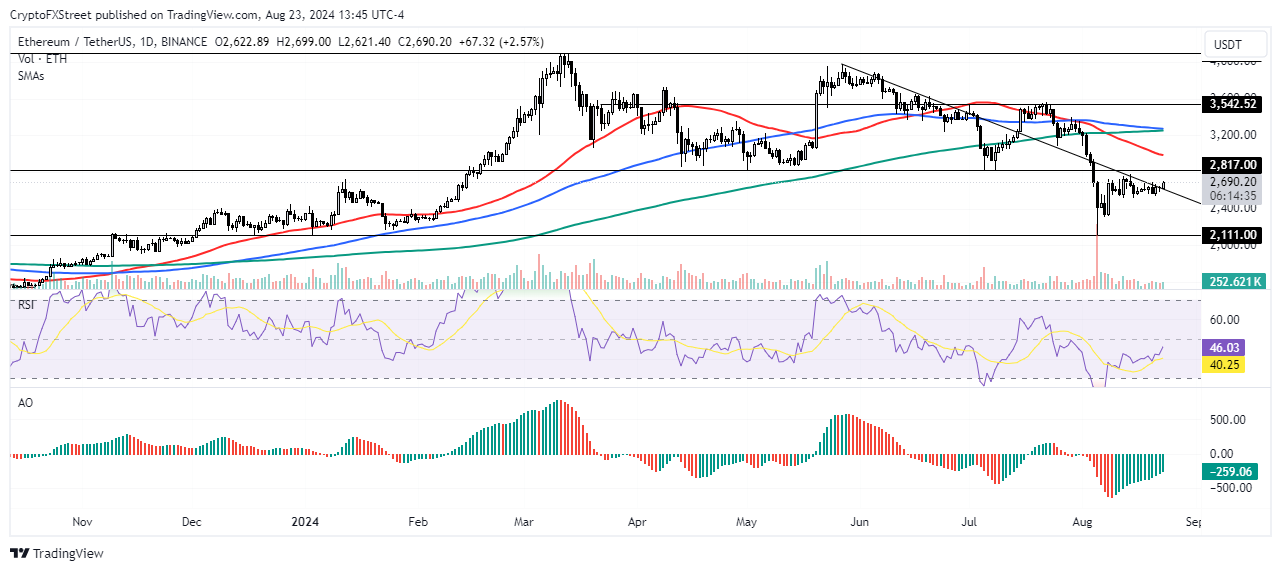Ethereum surges above $2,700 following Fed Chair's keynote, exchanges see exodus of 284K ETH
- Ethereum jumped by over 5% after Fed Chair confirmed that the central bank is looking to cut rates.
- ETH exchange net flows hit a two-month low after buyers moved over 283.9K ETH out of exchanges.
- Ethereum ETFs extend outflow streak to six consecutive days after Grayscale's ETHE offset positive flows in Fidelity's FETH.
- The top altcoin has the potential for a 30% rally if bulls can stage strong buying pressure to overcome a key rectangle's resistance.
Ethereum is up 5% on Friday as bulls have initiated heavy buying pressure following indications from US Federal Reserve (Fed) Chair Jerome Powell that an interest rate cut is imminent.
Daily digest market movers: Rate cuts, Ethereum outflows, ETF streak
Fed Chair Powell noted that an interest rate cut is on the horizon in his Friday morning keynote at Jackson Hole, Wyoming. "The time has come for policy to adjust," said Powell. "The direction of travel is clear, and the timing and pace of rate cuts will depend on incoming data, the evolving outlook, and the balance of risks."
Following his speech, Ethereum jumped alongside the crypto market by more than 2% as investors appeared to be regaining confidence in the top altcoin. Risk assets like cryptocurrencies tend to perform better during lower interest rate environments due to a lower cost of capital.
The buying pressure from investors is noticeable in Ethereum's exchange net flow, moving to 283.9K ETH in outflows — its lowest since June 11.
 - All Exchanges (SMA 7) (1)-638600330895889650.png)
ETH Exchange Netflow
Exchange net flow is the difference between coins flowing in/out of exchanges. Net outflows signify dominant buying pressure, while vice versa for net inflows.
The seven-day ETH exchange net flow moving average also plunged to 38,983 ETH in outflows.
Meanwhile, Ethereum ETFs look set to end the week with net outflows after extending their negative flows streak to six days on Thursday, per Farside Investors' data. The nine US spot ETH ETFs posted a combined net outflow of $800,000 — its lowest outflow day since launch.
Notably, Fidelity's FETH recorded net inflows of $14.3 million, while VanEck's ETHV and Grayscale's mini ETH saw inflows of $1 million and $3.7 million, respectively. However, their positive flows were offset by outflows of $19.8 million in Grayscale's ETHE.
The decrease in outflows combined with the wider market’s positive sentiment could help ETH ETFs record their first net inflows on Friday.
ETH technical analysis: Ethereum could rally 30% if it overcomes key rectangle's resistance
Ethereum is trading around $2,720 on Friday, up over 5% on the day. In the past 24 hours, ETH has seen over $26.97 million in liquidations, with long and short liquidations accounting for $12.84 and $14.13 million, respectively.
ETH has been trading within a key rectangle since the market crash on August 5. The $2,817 price, which served as a key support level for five months from March to July, has been a key resistance after ETH breached it on August 4.

ETH/USDT Daily chart
A key trendline extending from May 27 to September 25 has also kept ETH's price at bay.
However, with the Fed Chair confirming a rate cut is imminent, ETH could overcome the $2,817 resistance and stage a 30% rally toward $3,542. A breakout above $3,542 could see ETH attempt a move toward its yearly resistance of $4,093.
ETH faces resistance from the 100-day and 200-day Simple Moving Averages (SMA) on the way up.
The moving average of the Relative Strength Index (RSI) has been rising after posting a lower low on August 15. A cross above its midline could give strength to a bullish move.
The Awesome Oscillator (AO) has been posting consistent lower green bars below zero since reaching a low on August 10, indicating that the bearish momentum is weakening.
Ethereum FAQs
Ethereum is a decentralized open-source blockchain with smart contracts functionality. Serving as the basal network for the Ether (ETH) cryptocurrency, it is the second largest crypto and largest altcoin by market capitalization. The Ethereum network is tailored for scalability, programmability, security, and decentralization, attributes that make it popular among developers.
Ethereum uses decentralized blockchain technology, where developers can build and deploy applications that are independent of the central authority. To make this easier, the network has a programming language in place, which helps users create self-executing smart contracts. A smart contract is basically a code that can be verified and allows inter-user transactions.
Staking is a process where investors grow their portfolios by locking their assets for a specified duration instead of selling them. It is used by most blockchains, especially the ones that employ Proof-of-Stake (PoS) mechanism, with users earning rewards as an incentive for committing their tokens. For most long-term cryptocurrency holders, staking is a strategy to make passive income from your assets, putting them to work in exchange for reward generation.
Ethereum transitioned from a Proof-of-Work (PoW) to a Proof-of-Stake (PoS) mechanism in an event christened “The Merge.” The transformation came as the network wanted to achieve more security, cut down on energy consumption by 99.95%, and execute new scaling solutions with a possible threshold of 100,000 transactions per second. With PoS, there are less entry barriers for miners considering the reduced energy demands.

